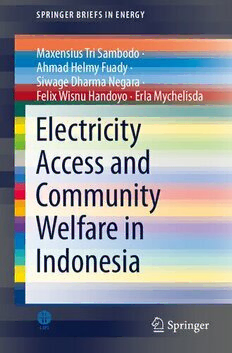
Electricity Access and Community Welfare in Indonesia PDF
Preview Electricity Access and Community Welfare in Indonesia
SPRINGER BRIEFS IN ENERGY Maxensius Tri Sambodo · Ahmad Helmy Fuady · Siwage Dharma Negara · Felix Wisnu Handoyo · Erla Mychelisda Electricity Access and Community Welfare in Indonesia 123 SpringerBriefs in Energy SpringerBriefsinEnergypresentsconcisesummariesofcutting-edgeresearchand practical applications in all aspects of Energy. Featuring compact volumes of 50 to 125 pages, the series covers a range of content from professional to academic. Typicaltopicsmightinclude: (cid:129) Asnapshotofahotoremergingtopic (cid:129) Acontextualliteraturereview (cid:129) Atimelyreportofstate-of-theartanalyticaltechniques (cid:129) Anin-depthcasestudy (cid:129) Apresentationofcoreconceptsthatstudentsmustunderstandinordertomake independentcontributions. Briefsallowauthorstopresenttheirideasandreaderstoabsorbthemwithminimal timeinvestment. Briefs will be published as part of Springer’s eBook collection, with millions of users worldwide. In addition, Briefs will be available for individual print and electronicpurchase.Briefsarecharacterizedbyfast,globalelectronicdissemination, standard publishing contracts, easy-to-use manuscript preparation and formatting guidelines,andexpeditedproductionschedules.Weaimforpublication8–12weeks afteracceptance. Bothsolicitedandunsolicitedmanuscriptsareconsideredforpublicationinthis series. Briefs can also arise from the scale up of a planned chapter. Instead of simplycontributingtoaneditedvolume,theauthorgetsanauthoredbookwiththe spacenecessarytoprovidemoredata,fundamentalsandbackgroundonthesubject, methodology,futureoutlook,etc. SpringerBriefsinEnergycontainsadistinctsubseriesfocusingonEnergyAnal- ysis and edited by Charles Hall, State University of New York. Books for this subseries will emphasize quantitative accounting of energy use and availability, including the potential and limitations of new technologies in terms of energy returnedonenergyinvested. Moreinformationaboutthisseriesathttp://www.springer.com/series/8903 · · Maxensius Tri Sambodo Ahmad Helmy Fuady · · Siwage Dharma Negara Felix Wisnu Handoyo Erla Mychelisda Electricity Access and Community Welfare in Indonesia MaxensiusTriSambodo AhmadHelmyFuady EconomicResearchCenter ResearchCenterforAreaStudies GedungWidyaGrahaLIPI IndonesianInstituteofSciences(LIPI) IndonesianInstituteofSciences(LIPI) Jakarta,Indonesia KotaJakartaSelatan Jakarta,Indonesia FelixWisnuHandoyo EconomicResearchCenter SiwageDharmaNegara GedungWidyaGrahaLIPI ISEASYusofIshakInstitute IndonesianInstituteofSciences(LIPI) Singapore,Singapore KotaJakartaSelatan Jakarta,Indonesia ErlaMychelisda EconomicResearchCenter GedungWidyaGrahaLIPI IndonesianInstituteofSciences(LIPI) KotaJakartaSelatan Jakarta,Indonesia ISSN2191-5520 ISSN2191-5539 (electronic) SpringerBriefsinEnergy ISBN978-981-16-3613-4 ISBN978-981-16-3611-0 (eBook) https://doi.org/10.1007/978-981-16-3611-0 ©TheAuthor(s),underexclusivelicensetoSpringerNatureSingaporePteLtd.2021 Thisworkissubjecttocopyright.AllrightsaresolelyandexclusivelylicensedbythePublisher,whether thewholeorpartofthematerialisconcerned,specificallytherightsoftranslation,reprinting,reuse ofillustrations,recitation,broadcasting,reproductiononmicrofilmsorinanyotherphysicalway,and transmissionorinformationstorageandretrieval,electronicadaptation,computersoftware,orbysimilar ordissimilarmethodologynowknownorhereafterdeveloped. Theuseofgeneraldescriptivenames,registerednames,trademarks,servicemarks,etc.inthispublication doesnotimply,evenintheabsenceofaspecificstatement,thatsuchnamesareexemptfromtherelevant protectivelawsandregulationsandthereforefreeforgeneraluse. Thepublisher,theauthorsandtheeditorsaresafetoassumethattheadviceandinformationinthisbook arebelievedtobetrueandaccurateatthedateofpublication.Neitherthepublishernortheauthorsor theeditorsgiveawarranty,expressedorimplied,withrespecttothematerialcontainedhereinorforany errorsoromissionsthatmayhavebeenmade.Thepublisherremainsneutralwithregardtojurisdictional claimsinpublishedmapsandinstitutionalaffiliations. ThisSpringerimprintispublishedbytheregisteredcompanySpringerNatureSingaporePteLtd. The registered company address is: 152 Beach Road, #21-01/04 Gateway East, Singapore 189721, Singapore Foreword SustainableDevelopmentGoal(SDG)Number7mentions‘Ensureaccesstoafford- able,reliable,sustainableandmodernenergyforallby2030.’Thisgoalhasavery importantmeaningformanycountriesfacingthechallengesofaccesstoelectricity, includingIndonesia.Refertothejointreportof‘trackingSDG7theenergyprogress report2020’byIEA,IRENA,UnitedNations,WorldBank,andWorldHealthOrga- nization,saidthatBangladesh,India,Indonesia,andthePhilippinesarewellontrack toreachfullaccessbefore2030. However, this projection still needs to be supported by the better performance ofallpartieswhoareresponsibleforincreasingaccesstoelectricity.Reflectingon Indonesia’ssuccessstoryinincreasingaccesstoelectricity,itisverygoodtolearn fromthemanyvaluableexperiencesdiscussedinthisbook.Thisbookrepresentsa synthesisofresearchfindingsonenergyinremoteruralareasinEastNusaTenggara (NTT). The locus of the study is the finest example of an underdeveloped area in easternIndonesiafacingwithseriousenergypovertyproblems.Fortwoconsecutive yearsofresearch(2013and2014),wetriedtomeasurecarefullytheimpactsofaccess toelectricityonthepeople’swelfare.Thisbookdiscussessomeprofoundresultsof afieldresearchtowhichdecisionmakersneedtopaytheirattention. ThisbookhasbeenpublishedinanIndonesianeditionentitled‘AksesListrikdan KesejahteraanMasyarakat.’Theauthorsattempttoupdatethedataanddiscussthe study findings in the context of the current policies. Additional analysis and data updatingweremadeasrequestedbybookreviewerswhenpublishedintheEnglish version.Inthisway,thisbookcancomplementthepublicationinIndonesian. We would like to take this opportunity to thank all those who have helped in preparingandcarryingouttheresearchaswellaswritingthefinalreport.Ourgrati- tudegoesparticularlytothesubprogramcoordinatorsofcompetitiveresearchactiv- ities, resource persons, discussants, panelists, and participants in our focus group discussions or seminars for their valuable feedback and suggestions to make this v vi Foreword study well developed. We hope the book becomes a significant reference to any policymakers and observers having a particular interest in the electricity sector in Indonesia. Jakarta,Indonesia TheResearchTeam Publisher’s Note LembagaIlmuPengetahuanIndonesia(LIPI)Press,asascientificpublisher,hasthe responsibilitytoproducehigh-qualityscientificpublications.Thefulfillmentofthis statutoryobligationisoneofthepublisher’srolesinpromotingtheeducationaland intellectuallifeofthenationasmandatedbyPreambleofthe1945Constitution. This anthology of Electricity Access and Community Welfare presents research findingsontheimpactsofelectricityaccessonthecommunitywelfareinsomerural andremoteareasinEastNusaTenggara(NTT)wheretheresearchwasconducted. Wehopethatthisbookwillaidthereadersinfindingsourcesofinformationon theimpactsofelectricityaccessonthewelfareofcommunitieslivinginremoterural areas.Itisofourexpectationthatthisbookwillalsobecomeausefulreferencefor researchers, policymakers, and observers working in the electricity sector. Finally, wethankallthosewhomadethispublicationpossible. LIPIPress vii Contents 1 Introduction:AccesstoElectricityandWelfare .................... 1 1.1 Background ................................................ 1 1.2 Framework ................................................. 5 1.3 ScopeandMethodology(inBrief) ............................. 6 1.4 ResearchFindings ........................................... 9 References ...................................................... 10 2 PotentialofEnergyResourcesinEastNusaTenggara ............... 11 2.1 TheEnergySectorinNTTProvince:AnOverview ............... 11 2.2 EnergyPotentialsinNTT ..................................... 13 2.3 KnowingthePotentialandPowerGenerationSourcesinNTT Province ................................................... 16 2.3.1 FossilPowerPlant .................................... 16 2.3.2 HydroPowerPlant .................................... 17 2.3.3 OceanCurrentPowerPlant ............................. 18 2.3.4 WindPowerPlant ..................................... 19 2.3.5 SolarPowerPlant ..................................... 20 2.3.6 GeothermalPowerPlant ............................... 22 2.3.7 BioenergyPowerPlant ................................. 23 2.4 ConditionofPowerPlantsinManggaraiDistrict ................. 23 2.4.1 EnergyPotentialsandConditioninSatarmese ............. 25 2.5 EnergyPotentialsandUtilizationinWewoVillage ............... 26 2.6 EnergyPotentialsandConditioninLungarVillage ............... 28 2.7 ProfileofElectricityDemandandSupplyintheResearchSites .... 30 2.8 Conclusion ................................................. 31 References ...................................................... 32 3 Political Economy of Geothermal Utilization: Cultivating thePotentialofUlumbuforWelfareImprovement .................. 35 3.1 Introduction ................................................ 35 3.2 PortraitofDisparitiesinElectricityDevelopments ............... 36 3.3 GeothermalUtilizationinIndonesia ............................ 37 ix x Contents 3.4 PLTPUlumbuandRegionalGovernment’sHope ................. 41 3.5 Conclusion ................................................. 43 References ...................................................... 44 4 Electricity Access and Community Welfare: A Case Study ofSatarmese-NTT ............................................... 47 4.1 Introduction ................................................ 47 4.2 ALiteratureReviewonElectricityandCommunityWelfare ....... 49 4.3 DescriptiveStatisticsandEconometricModels .................. 52 4.4 EconometricModel:PanelData ............................... 56 4.5 EstimationResultsofPanelData .............................. 58 4.6 ModelofDifferenceinDifferences ............................ 62 4.7 DirectImpactsofElectricityAccess ............................ 65 4.8 Conclusion ................................................. 66 References ...................................................... 67 5 Epilogue:AgendaforDevelopmentofRuralElectrification ......... 69 5.1 Introduction ................................................ 69 5.2 EvaluatingtheElectrificationPrograms ......................... 71 5.3 AnalyzingtheSuccessandFailureofRuralElectricityPrograms ... 74 5.4 InstitutionalReforms ......................................... 79 5.5 ModelScenariosofOff-GridElectricity ........................ 82 5.6 ElectricityDevelopmentandPovertyReduction .................. 86 References ...................................................... 88 Index ............................................................. 91
